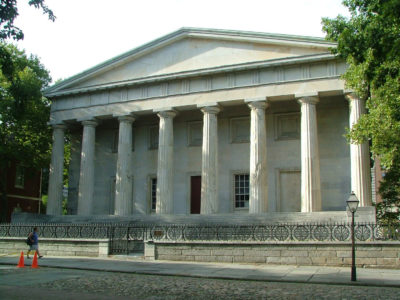- We would reduce federal income tax to 10% on individual gross revenue (income prior to expenses) minus deductions for money given to other people (who would be taxed for this money instead). The entire amount would be placed into the National Public Bank, per its constitutional duty to ‘lay and collect taxes’.
- This ‘tax’ would then be turned into an ‘investment’. Each year, the total income tax collected would be divided by the number of living U.S. residents (as of January 1st of that year), then deposited into each person’s account accordingly; each would have a designated account number – perhaps simply retaining their current social security number. This money would function as a ‘retirement dividend’, and be paid out like an annuity, available as early as age 51 if requested, although the monthly payout would grow in size the longer each resident chose to wait before collecting this benefit.
- The National Public Bank would have a branch in every community of 100,000 residents. An amount equal to each resident’s share X 100,000 would be deposited into every bank branch annually, in order to build whatever infrastructure the community deems ‘necessary and proper’ to ‘promote the general welfare’ of its residents. These areas would include health care, education, housing, food, water / sewer, communication, transportation, and energy. Small business loans are possible if the business falls under one of these ‘necessary and proper’ categories.
- When an individual chooses to begin receiving ‘retirement dividends’, their community branch can handle the arrangements. As many as three million residents die each year, leaving a substantial amount remaining in their accounts, and it would be up to the federal government to clearly outline where this money would go. The Third Option suggests it should help pay for either health care or education needs, but as this is the property of the people, it should definitely go toward promoting ‘the general welfare’.
- Private banks are allowed to create the money they loan, meaning the money did not exist prior to the loan being issued. The bank ‘credits’ a borrower with loaned money, and records it simultaneously as a ‘debit’ in their books, to be paid back – with interest – by the borrower. In the National Public Bank, it is important to note that the initial investment of tax money into the bank is real, not ‘created’. With created money, once the loan is paid back, the ‘principle’ is ‘destroyed’, and the only real gain is the interest charged on the loan. In the National Public Bank, when money is paid back – with 4% interest over a 30-year period – principle and interest remain in the Bank, allowing for a much more substantial retirement dividend to accrue.
- To maximize our ‘return on investment’, while minimizing the cost of all these ‘necessary and proper’ essential needs, the Bank would give out 30-year loans at 4% interest. Once these loans are paid off, money would still flow into the Bank, from the continued payment of utility bills, health care premiums, housing rent, etc., which would provide more potential dividends until this infrastructure needs to be built again.

